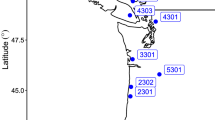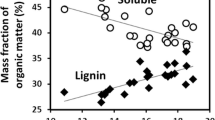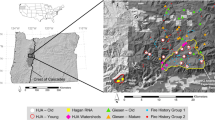Abstract
Accurately predicting the effects of global change on net carbon (C) exchange between terrestrial ecosystems and the atmosphere requires a more complete understanding of how nutrient availability regulates both plant growth and heterotrophic soil respiration. Models of soil development suggest that the nature of nutrient limitation changes over the course of ecosystem development, transitioning from nitrogen (N) limitation in ‘young’ sites to phosphorus (P) limitation in ‘old’ sites. However, previous research has focused primarily on plant responses to added nutrients, and the applicability of nutrient limitation-soil development models to belowground processes has not been thoroughly investigated. Here, we assessed the effects of nutrients on soil C cycling in three different forests that occupy a 4 million year substrate age chronosequence where tree growth is N limited at the youngest site, co-limited by N and P at the intermediate-aged site, and P limited at the oldest site. Our goal was to use short-term laboratory soil C manipulations (using 14C-labeled substrates) and longer-term intact soil core incubations to compare belowground responses to fertilization with aboveground patterns. When nutrients were applied with labile C (sucrose), patterns of microbial nutrient limitation were similar to plant patterns: microbial activity was limited more by N than by P in the young site, and P was more limiting than N in the old site. However, in the absence of C additions, increased respiration of native soil organic matter only occurred with simultaneous additions of N and P. Taken together, these data suggest that altered nutrient inputs into ecosystems could have dissimilar effects on C cycling above- and belowground, that nutrients may differentially affect of the fate of different soil C pools, and that future changes to the net C balance of terrestrial ecosystems will be partially regulated by soil nutrient status.



Similar content being viewed by others
References
Anderson JPE, Domsch KH (1978) A physiological method for the quantitative measurement of microbial biomass in soils. Soil Biol Biochem 10:215–221
Billings SA, Lichter J, Ziegler SE, Hungate BA, Richter DB (2010) A call to investigate drivers of soil organic matter retention vs. mineralization in a high CO2 world. Soil Biol Biochem 42:665–668
Bowman WD, Steltzer H, Rosenstiel TN, Cleveland CC, Meier CL (2004) Litter effects of two co-occurring alpine species on plant growth, microbial activity and immobilization of nitrogen. Oikos 104:336–344
Bradford MA, Fierer N, Reynolds JF (2008a) Soil carbon stocks in experimental mesocosms are dependent on the rate of labile carbon, nitrogen and phosphorus inputs to soils. Funct Ecol 22:964–974
Bradford MA, Fierer N, Jackson RB, Maddox TR, Reynolds JF (2008b) Nonlinear root-derived carbon sequestration across a gradient of nitrogen and phosphorus deposition in experimental mesocosms. Glob Change Biol 14:1113–1124
Brookes PC, Powlson DS, Jenkinson DS (1984) Phosphorus in the soil microbial biomass. Soil Biol Biochem 16:169–175
Brookes PC, Landman A, Pruden G, Jenkinson DS (1985) Chloroform fumigation and the release of soil nitrogen: a rapid direct extraction method to measure microbial biomass nitrogen in soil. Soil Biol Biochem 17:837–842
Burton AJ, Pregitzer KS, Crawford JN, Zogg GP, Zak DR (2004) Chronic NO3 − additions reduce soil respiration in northern hardwood forests. Glob Change Biol 10:1080–1091
Chadwick OA, Derry LA, Vitousek PM, Huebert BJ, Hedin LO (1999) Changing sources of nutrients during four million years of ecosystem development. Nature 397:491–497
Cleveland CC, Liptzin D (2007) C:N:P stoichiometry in soil: is there a “Redfield ratio” for the microbial biomass? Biogeochemistry 85:235–252
Cleveland C, Townsend AR (2006) Nutrient additions to a tropical rain forest drive substantial soil carbon dioxide losses to the atmosphere. Proc Natl Acad Sci USA 103:10316–10321
Cleveland C, Townsend AR, Schmidt SK (2002) Phosphorus limitation of microbial processes in moist tropical forests: evidence from short-term laboratory incubations and field studies. Ecosystems 5:680–691
Cleveland CC, Nemergut DR, Schmidt SK, Townsend AR (2006) Increases in soil respiration following labile carbon additions linked to rapid shifts in soil microbial community composition. Biogeochemistry 82:229–240
Colores GM, Schmidt SK, Fisk MC (1996) Estimating the biomass of microbial functional groups using rates of growth-related soil respiration. Soil Biol Biochem 28:1569–1577
Compton J, Mallinson D, Glenn CR, Filippelli G, Föllmi K, Shields G, Zanin Y (2000) Variations in the global phosphorus cycle. In: Glenn C, Prevot-Lucas L, Lucas J (eds) Marine authigenesis: From microbial to global SEPM special publication 66. Society for Sedimentary Geology, Tulsa
Crews TE, Kitayama K, Fownes JH, Riley RH, Herbert DA, Mueller-Dombois D, Vitousek PM (1995) Changes in soil phosphorus fractions and ecosystem dynamics across a long chronosequence in Hawaii. Ecology 76:1407–1424
DeForest JL, Zak DR, Pregitzer KS, Burton AJ (2004) Nitrate deposition and the microbial degradation of cellulose and lignin in a northern hardwood forest. Soil Biol Biochem 36:965–971
Elser JJ et al (2007) Global analysis of nitrogen and phosphorus limitation of primary producers in freshwater marine and terrestrial ecosystems. Ecol Lett 10:1135–1142
Filippelli GM (2002) The global phosphorus cycle. Rev Miner Geochem 48:391–425
Fogg K (1988) The effect of added nitrogen on the rate of decomposition of organic matter. Biol Rev 63:433–462
Gallardo A, Schlesinger WH (1994) Factors limiting microbial biomass in the mineral soil and forest floor of a warm-temperate forest. Soil Biol Biochem 26:1409–1415
Galloway JN et al (2004) Nitrogen cycles: past present and future. Biogeochemistry 70:153–226
Grace J, Malhi Y, Higuchi N, Meir P (2001) Tropical forests. In: Mooney HA, Roy J, Saugier B (eds) Terrestrial global productivity: past, present and future. Academic Press, London
Harrington RA, Fownes JH, Vitousek PM (2001) Production and resource use efficiencies in N- and P-limited tropical forests: a comparison of responses to long-term fertilization. Ecosystems 4:646–657
Haynes BE, Gower ST (1995) Belowground carbon allocation in unfertilized and fertilized red pine plantations in northern Wisconsin. Tree Physiol 15:317–325
Herbert DA, Fownes JH (1995) Phosphorus limitation of forest leaf area and net primary productivity on highly weathered tropical montane soils in Hawaii. Biogeochemistry 29:223–235
Herbert DA, Fownes JH (1999) Forest productivity and efficiency of resource use across a chronosequence of tropical montane soils. Ecosystems 2:242–254
Hobbie SE, Vitousek PM (2000) Nutrient limitation of decomposition in Hawaiian forests. Ecology 81:1867–1877
Ilstedt U, Singh S (2005) Nitrogen and phosphorus limitations of microbial respiration in a tropical phosphorus-fixing acrisol (ultisol) compared with organic compost. Soil Biol Biochem 37:1407–1410
Knorr MS, Frey D, Curtis PS (2005) Nitrogen additions and litter decomposition: a meta-analysis. Ecology 86:3252–3257
Kuo S (1996) Phosphorus. In: Sparks DL (ed) Methods of soil analysis. Part 3: Chemical methods. Soil Society of America, Madison
Kuzyakov Y, Friedel JK, Stahr K (2000) Review of mechanisms and quantification of priming effects. Soil Biol Biochem 32:1485–1498
Larcher W (ed) (2001) Environmental influences on growth and development. In: Physiological plant ecology, 4th edn. Springer, Berlin
LeBauer DS, Treseder KK (2008) Nitrogen limitation of net primary productivity in terrestrial ecosystems is globally distributed. Ecology 89:371–379
Ley RE, Williams MW, Schmidt SK (2004) Microbial population dynamics in an extreme environment: controlling factors in talus soils at 3750 m in the Colorado Rocky Mountains. Biogeochemistry 68:313–335
Lipson DA, Schmidt SK, Monson RK (2000) Carbon availability and temperature control the post-snowmelt decline in alpine soil microbial biomass. Soil Biol Biochem 32:441–448
Matson PA, McDowell WH, Townsend AR, Vitousek PM (1999) The globalization of N deposition: ecosystem consequences in tropical environments. Biogeochemistry 46:67–83
Meier CL, Bowman WD (2008) Links between plant litter chemistry, species diversity, and below-ground ecosystem function. Proc Natl Acad Sci USA 105:19780–19785
Neff JC, Townsend AR, Gleixner G, Lehman SJ, Turnbull J, Bowman WD (2003) Variable effects of nitrogen additions on the stability and turnover of soil carbon. Nature 419:915–917
Okin GS, Mahowald N, Chadwick OA, Artaxo P (2004) Impact of desert dust on the biogeochemistry of phosphorus in terrestrial ecosystems. Glob Biogeochem Cycles 18:GB2005
Olander LP, Vitousek PM (2000) Regulation of soil phosphatase and chitinase activity by N and P availability. Biogeochemistry 49:175–190
Olander LP, Vitousek PM (2005) Short-term controls over inorganic phosphorus during soil and ecosystem development. Soil Biol Biochem 37:651–659
Olsson P, Linder S, Giesler R, Högberg P (2005) Fertilization of boreal forest reduces both autotrophic and heterotrophic soil respiration. Glob Change Biol 11:1745–1753
Phillips OL et al (1998) Changes in the carbon balance of tropical forests: evidence from long-term plots. Science 282:439–442
Pregitzer KS, Burton AJ, Zak DR, Talhelm AF (2008) Simulated chronic N deposition increases carbon storage in northern temperate forests. Glob Change Biol 14:142–153
Reiners W (1986) Complementary models for ecosystems. Am Nat 127:59–73
Schimel JP, Weintraub MN (2003) The implications of exoenzyme activity on microbial carbon and nitrogen limitation in soil: a theoretical model. Soil Biol Biochem 35:549–563
Schimel DS, Brasswell BH, Holland E, McKeown R, Ojima D, Painter TH, Parton WJ, Townsend AR (1994) Climatic edaphic and biotic controls over storage and turnover of carbon in soils. Glob Biogeochem Cycles 8:279–295
Sterner RW, Elser JJ (2002) Ecological stoichiometry: the biology of elements from molecules to the biosphere. Princeton University Press, New Jersey
Thornton PE, Doney SC, Lindsay K, Moore JK, Mahowald N, Randerson JT, Fung I, Lamarque JF, Feddema JJ, Lee YH (2009) Carbon-nitrogen interactions regulate climate-carbon cycle feedbacks: results from an atmosphere-ocean general circulation model. Biogeosciences 6:2099–2120
Torn MS, Vitousek PM, Trumbore SE (2005) The influence of nutrient availability on soil organic matter turnover estimated by incubations and radiocarbon modeling. Ecosystems 8:352–372
Townsend AR, Vitousek PM, Trumbore SE (1997) Soil carbon pool structure and temperature sensitivity inferred using CO2 and 13CO2 incubation fluxes from five Hawaiian soils. Biogeochemistry 38:1–17
Treseder KK (2008) Nitrogen additions and microbial biomass: a meta-analysis of ecosystem studies. Ecol Lett 11:1111–1120
Valentini R et al (2000) Respiration as the main determinant of carbon balance in European forests. Nature 404:861–865
van der Putten WH et al (2009) Empirical and theoretical challenges in aboveground–belowground ecology. Oecologia 161:1–14
Vance ED, Brookes PC, Jenkinson DS (1987) An extraction method for measuring soil microbial biomass C. Soil Biol Biochem 19:703–707
Vitousek PM (2004) Nutrient cycling and limitation: Hawai’i as a model system. Princeton University Press, New Jersey
Vitousek PM, Farrington H (1997) Nutrient limitation and soil development: experimental test of a biogeochemical theory. Biogeochemistry 37:63–75
Vitousek PM, Reiners WA (1975) Ecosystem succession and nutrient retention: a hypothesis. Bioscience 25:376–381
Vitousek PM, Porder S, Houlton BZ, Chadwick O (2010) Terrestrial phosphorus limitation: mechanisms, implications and nitrogen-phosphorus interactions. Ecol Appl 20:5–15
Walker TW, Syers JK (1976) The fate of phosphorus during pedogenesis. Geoderma 15:1–19
Wieder WR, Cleveland CC, Townsend AR (2008) Tropical tree species composition affects the oxidation of dissolved organic matter from litter. Biogeochemistry 88:127–138
Zak DR, Holmes WE, Burton AJ, Pregitzer KS, Talhelm AF (2008) Simulated atmospheric NO3 − deposition increases soil organic matter by slowing decomposition. Ecol Appl 18:2016–2027
Acknowledgments
We are indebted to Heraldo Farrington for his advice and assistance in the field, to Jonathan Leff for excellent help with laboratory analyses, and to Tim Crews, Margaret Torn, David Lipson, and Alan Townsend for their willingness to share unpublished data and offer advice. We are grateful to two anonymous reviewers whose comments greatly improved a previous draft of this manuscript. We are grateful to Walt Hill, Stephen Lodmell, and Jean-Marc Lanchy for access to and help with their liquid scintillation counter. We thank the Division of Forestry and Wildlife of the State of Hawai’i and Koke’e State Park for their logistical assistance and for allowing us access to the sites. Any use of trade names is for descriptive purposes only and does not imply endorsement by the U.S. Government. This research was funded by Andrew W. Mellon Foundation grants to C.C. and P.V.
Author information
Authors and Affiliations
Corresponding author
Rights and permissions
About this article
Cite this article
Reed, S.C., Vitousek, P.M. & Cleveland, C.C. Are patterns in nutrient limitation belowground consistent with those aboveground: results from a 4 million year chronosequence. Biogeochemistry 106, 323–336 (2011). https://doi.org/10.1007/s10533-010-9522-6
Received:
Accepted:
Published:
Issue Date:
DOI: https://doi.org/10.1007/s10533-010-9522-6




